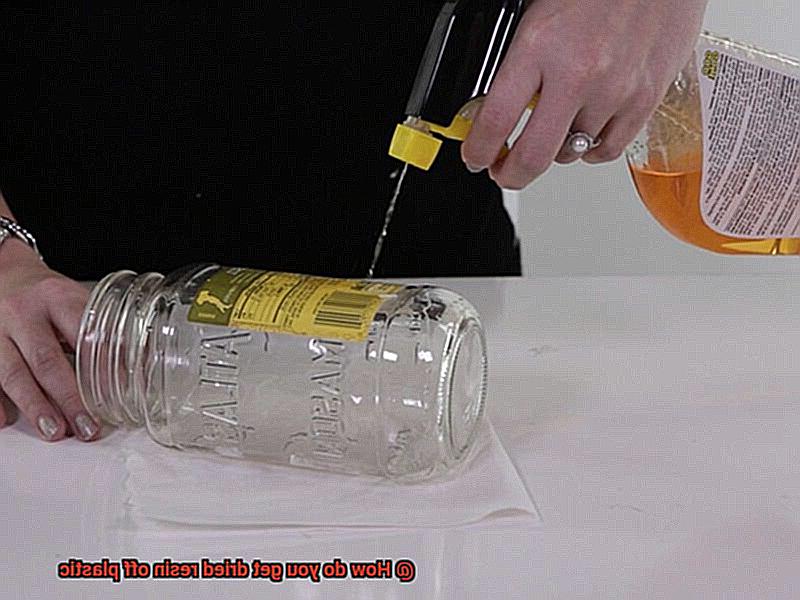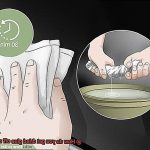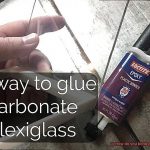Resin art has taken the crafting world by storm, and it’s no wonder why. It’s a versatile and creative way to make stunning pieces of art. But let’s face it, cleaning up after the messy process can be a real nightmare. Resin is notorious for sticking to almost everything, including plastic – but fear not. If you’re an avid resin artist or have accidentally spilled resin on plastic surfaces, this blog post is here to save the day. We’ll show you how to get dried resin off plastic quickly and effectively.
But before we dive into the “how,” let’s first understand what resin is and why it’s so darn sticky. Resin is a compound made of two parts – a liquid resin and a hardener. When these two parts are mixed together, they undergo a chemical reaction that results in stickiness – which makes it challenging to remove from plastic surfaces.
In the following sections, we’ll outline various methods to help you get dried resin off plastic. From using heat to freezing the resin – we’ve got all the tricks up our sleeves. So whether you’re a beginner or a pro, keep reading, and we’ll help you get your plastic surfaces looking brand new in no time at all.
Types of Plastic Surfaces
Contents
- 1 Types of Plastic Surfaces
- 1.1 Polystyrene: This type of plastic is often found in disposable cups and food containers. It is more reactive than polyethylene and can be dissolved by solvents like acetone or alcohol. However, using solvents on polystyrene can also cause the plastic to become brittle or discolored.
- 1.2 PET: PET is a plastic commonly used in soda bottles. It has moderate resistance to solvents, meaning that a combination of mechanical methods and solvents may be necessary for removing dried resin from this surface.
- 2 Cleaning Solutions for Resin Removal
- 3 Rubbing Alcohol or Nail Polish Remover
- 4 Heat Gun or Hair Dryer Method
- 5 Commercial Adhesive Removers
- 6 Tips and Tricks for Removing Dried Resin from Plastic
- 7 Pros and Cons of Different Methods
- 8 Conclusion
Resin can be a fantastic material for creating beautiful and unique projects, but it can also be a nightmare to remove when it dries on plastic surfaces. The type of plastic surface you are working with can greatly affect the removal process, so it’s essential to understand the different types of plastics and how they react to various removal methods.
- Polyethylene: This soft and pliable plastic is commonly used in packaging materials such as milk jugs and plastic bags. On the downside, it is prone to scratching, which means that extra care should be taken when attempting to remove dried resin. Mechanical methods such as scraping or sanding may be necessary for removing dried resin from this surface.
- Polycarbonate: This hard and durable plastic is commonly used in items like eyeglasses and electronic devices. Its strength makes removing dried resin more challenging, while its susceptibility to damage from certain chemicals means that caution should be used when attempting to remove dried resin from this surface.
-
Polystyrene: This type of plastic is often found in disposable cups and food containers. It is more reactive than polyethylene and can be dissolved by solvents like acetone or alcohol. However, using solvents on polystyrene can also cause the plastic to become brittle or discolored.
- PVC: PVC is a plastic commonly used in pipes and vinyl flooring. It has a high resistance to solvents, which makes removing dried resin a challenge. It may be necessary to use mechanical methods like scraping or sanding for this type of plastic surface.
-
PET: PET is a plastic commonly used in soda bottles. It has moderate resistance to solvents, meaning that a combination of mechanical methods and solvents may be necessary for removing dried resin from this surface.
- Acrylic: Acrylic is commonly used in display cases and light fixtures. It has moderate resistance to solvents, but using solvents can cause the plastic to become cloudy or discolored. In this case, mechanical methods may be necessary for removing dried resin from this surface.
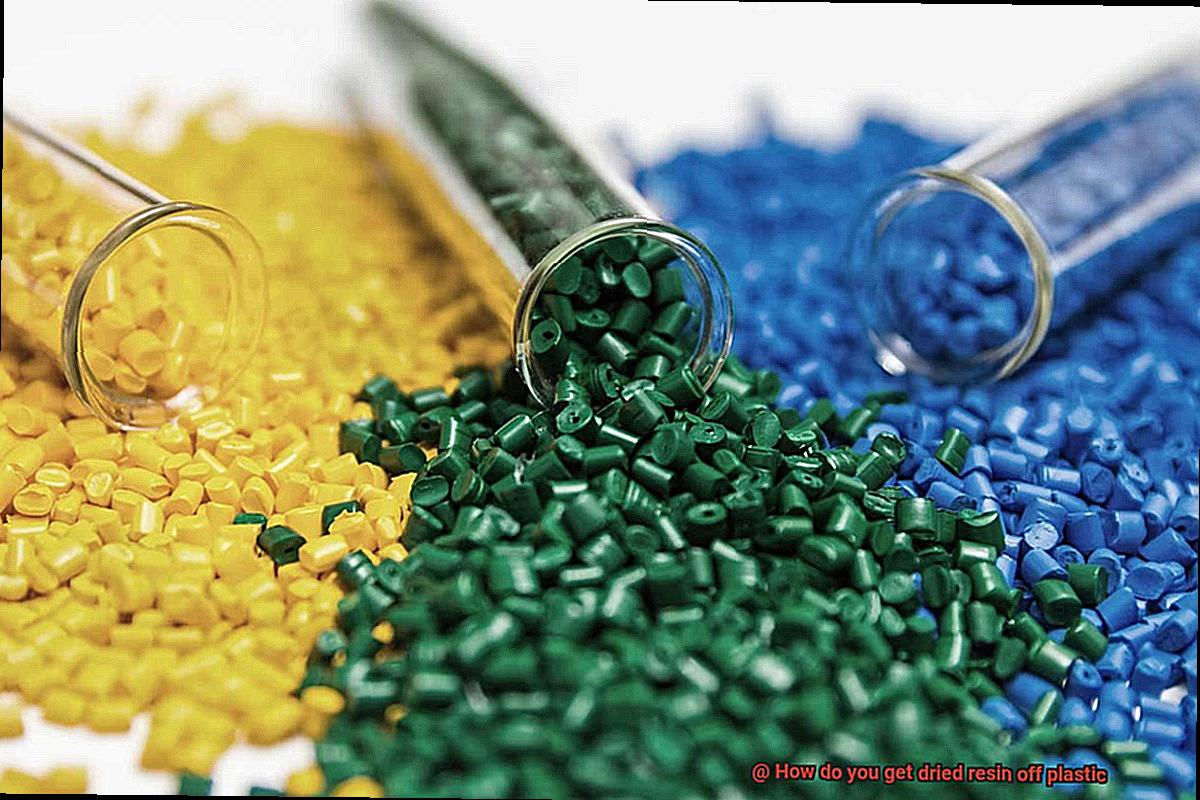
In summary, when it comes to removing dried resin from plastic surfaces, one size does not fit all. Understanding the type of plastic surface you are working with is essential to determine the most effective removal method without causing damage.
Cleaning Solutions for Resin Removal
Removing dried resin from plastic surfaces can be a daunting task, but with the right cleaning solutions, it can be a breeze. As an expert in this area, I highly recommend using rubbing alcohol and vinegar as your go-to cleaning solutions.
Rubbing alcohol is a popular choice for resin removal due to its solvent properties. It breaks down the resin and makes it easier to remove from plastic surfaces. To use rubbing alcohol for resin removal, apply it to a clean cloth and gently rub the affected area. The resin will dissolve and become easier to wipe away.
Vinegar is another effective cleaning solution that can break down the resin due to its acidic properties. Simply apply vinegar to a clean cloth and gently rub the affected area. The resin will dissolve, making it easier to wipe away.
If household items don’t work for your specific situation, you may need to consider using a specialized cleaner designed explicitly for resin removal. These cleaners are more potent than household solutions and can be found at hardware stores.
Before using any cleaning solution for resin removal, it’s essential to test a small area first to avoid damaging or discoloring the plastic surface. Always follow the instructions on the cleaning solution label and wear gloves and protective eyewear when working with chemicals.
Rubbing Alcohol or Nail Polish Remover
If you’re reading this, you’re probably facing the challenge of removing dried resin from plastic surfaces. Fear not, for there are two household heroes that can come to your rescue: rubbing alcohol and nail polish remover.
Rubbing alcohol, also known as isopropyl alcohol, is a versatile solvent that can dissolve many types of substances, including dried resin. It’s a simple solution – just soak a cotton ball or cloth in the alcohol and rub it onto the affected area. The alcohol breaks down the resin, making it easy to wipe away.
Nail polish remover, on the other hand, contains acetone which is a strong solvent that can dissolve many types of plastics as well as resin. However, it’s important to test a small area first before using nail polish remover on a larger area. To use nail polish remover to remove dried resin from plastic, apply a small amount to a cotton ball or cloth and gently rub the affected area. Be sure to rinse the plastic thoroughly with water after using nail polish remover.
But, before you get too excited about these quick fixes, it’s important to note that both rubbing alcohol and nail polish remover have their limitations. They can be harsh on some types of plastics if left in contact for an extended period of time. Additionally, these substances should be used in a well-ventilated area and kept away from flames or sparks as they are flammable.
Here are some key points to keep in mind:
- Rubbing alcohol can dissolve many types of substances including dried resin
- Nail polish remover contains acetone which is strong enough to dissolve many types of plastics
- Test a small area before using any solvent on a larger area
- Rinse the plastic thoroughly with water after using nail polish remover
- Both rubbing alcohol and nail polish remover can be harsh on certain types of plastics
- Use these substances in a well-ventilated area and keep them away from flames or sparks
Heat Gun or Hair Dryer Method
The heat gun or hair dryer method has become a popular approach to softening and removing dried resin from plastic surfaces. As an expert on this matter, I am here to provide insight into the process and offer tips for success.
To begin, gather your materials. You will need either a heat gun or hair dryer, a scraper, protective gloves, and goggles. Make sure to work in a well-ventilated area to avoid inhaling any fumes or dust particles that may be released during the process.
If you choose to use a heat gun, set it on low heat to avoid melting the plastic surface. Hold it about 2-3 inches away from the area with dried resin and move it back and forth until the resin starts to soften. For those using a hair dryer, set it on high heat for maximum effectiveness and follow the same process.
It is crucial to take caution when working with heated tools. Keep the heat source moving at all times and avoid overheating or melting the plastic surface. Once the resin is soft and pliable, use a scraper to gently remove it from the plastic surface.
Commercial Adhesive Removers
Commercial adhesive removers are here to save the day. With different types available, finding the right one for your needs is crucial.
Solvent-based removers are the heavy-duty option, able to remove even the toughest residue. However, they can be harsh on some plastics, so testing them on a small area is necessary before tackling the entire residue. If you do opt for a solvent-based remover, make sure to wear gloves and work in a well-ventilated area.
Citrus-based removers offer a gentle alternative with a pleasant citrus scent thanks to natural ingredients like orange oil. They work best on smaller areas with light residue but may require several applications for larger or thicker residue. Plus, they’re perfect for those who prefer eco-friendly solutions.
Finally, soy-based removers are non-toxic and eco-friendly, making them an excellent option for people who want to avoid harmful fumes. Although they take longer to work than solvent or citrus-based ones, they won’t damage the plastic surface and are gentle on the skin.
When using any commercial adhesive remover, always follow the manufacturer’s instructions carefully. Make sure to wear gloves and protective clothing to avoid skin irritation and work in a well-ventilated area. Apply the remover onto the dried resin using a cloth or brush and let it sit for a few minutes or as recommended by the manufacturer. Use a scraper or plastic spatula to gently remove the residue, being careful not to scratch or damage the plastic surface.
Tips and Tricks for Removing Dried Resin from Plastic
Removing dried resin from plastic can be a daunting task, but with the right techniques and tools, it is possible to restore your plastic surfaces back to their original condition. Here are some tips and tricks to help you effectively remove dried resin from plastic:
Apply Heat
One of the most effective ways to remove dried resin from plastic is by using heat. You can use a hairdryer or heat gun to soften the resin, making it easier to remove. However, be careful not to overheat the plastic as this can cause damage. Work carefully and patiently, applying heat in short bursts until the resin softens.
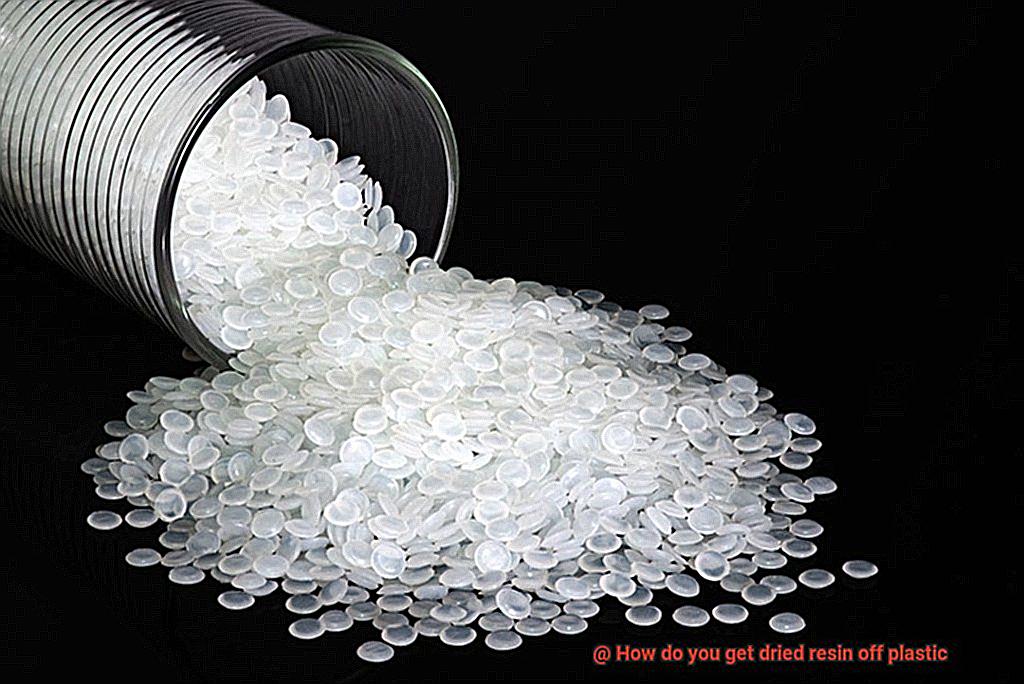
Use Rubbing Alcohol or Acetone
Rubbing alcohol and acetone are both effective solvents for resin. Apply a small amount of the solution onto a clean cloth and gently rub the affected area until the resin starts to dissolve. Be sure to test this method on a small, inconspicuous area of the plastic first to ensure that it does not cause any damage. Note that acetone can damage certain types of plastic, so be cautious with this method.
Use a Plastic Scraper
A plastic scraper can help you gently scrape away the dried resin without damaging the plastic surface. Hold the scraper at a slight angle and work slowly and carefully, taking care not to scratch or gouge the plastic.
Use Sandpaper
Sandpaper is another option for removing dried resin from plastic. Use a fine-grit sanding sponge or sandpaper to gently sand down the dried resin until it is no longer visible. However, be careful when using this method as working too aggressively can cause scratches or damage to the plastic.
Try a Commercial Resin Remover
If all else fails, you can try using a specialized adhesive remover designed for removing tough adhesives like resin. These products can be found at most hardware stores and are designed specifically for use on plastics. Be sure to follow the instructions carefully and use caution when handling these types of chemicals.
Pros and Cons of Different Methods
Removing dried resin from plastic can be a challenging task, but fear not – there are various methods available to tackle the job. However, it’s essential to note that each method has its own set of pros and cons that should be carefully considered before deciding which one to use.
One popular method is using solvents such as acetone or alcohol to dissolve the resin. This method is effective and can quickly break down the resin. However, it can also be harmful to the plastic if too much solvent is used. Additionally, solvents can be dangerous if not used properly, so caution should be taken when using them.
Another option is using heat to soften the resin, making it easier to scrape off. This method is less harmful to the plastic but requires a heat source and can be time-consuming. Be mindful of the heat level as too much heat can damage the plastic.
Mechanical methods like sanding or scraping can also be effective in removing dried resin from plastic. However, these methods can be time-consuming and may require special tools. They have the potential to damage the plastic if not done carefully.
Ultimately, selecting the best method will depend on several factors, including the type of resin and plastic involved and your personal preferences. It’s important to weigh up all of the pros and cons of each method before deciding which one to use. Consider using a combination of methods for more challenging cases.
MPvteGZYsjg” >
Conclusion
In summary, creating resin art is an enjoyable and rewarding experience, but it can be challenging to remove dried resin from plastic surfaces. Fortunately, there are several techniques available that can make the process more manageable.
Before attempting to remove dried resin from plastic, it’s crucial to understand the type of plastic surface you’re working with and how it reacts to different removal methods. This knowledge can help you avoid damaging the surface during the cleaning process.
Rubbing alcohol and vinegar are two effective cleaning solutions that can dissolve dried resin due to their solvent properties. They work well for removing small amounts of residue on plastic surfaces.
If you’re looking for a more hands-on approach, using a heat gun or hair dryer to soften and remove dried resin has become increasingly popular. However, it’s important to exercise caution when using heated tools and avoid overheating or melting the plastic surface.
For those who prefer natural ingredients, commercial adhesive removers like citrus-based or soy-based ones offer a gentle alternative with ingredients like orange oil. Always follow the manufacturer’s instructions carefully when using any commercial adhesive remover.
Ultimately, selecting the best method will depend on various factors such as the type of resin and plastic involved and personal preferences. For more challenging cases, consider combining multiple methods for optimal results.

